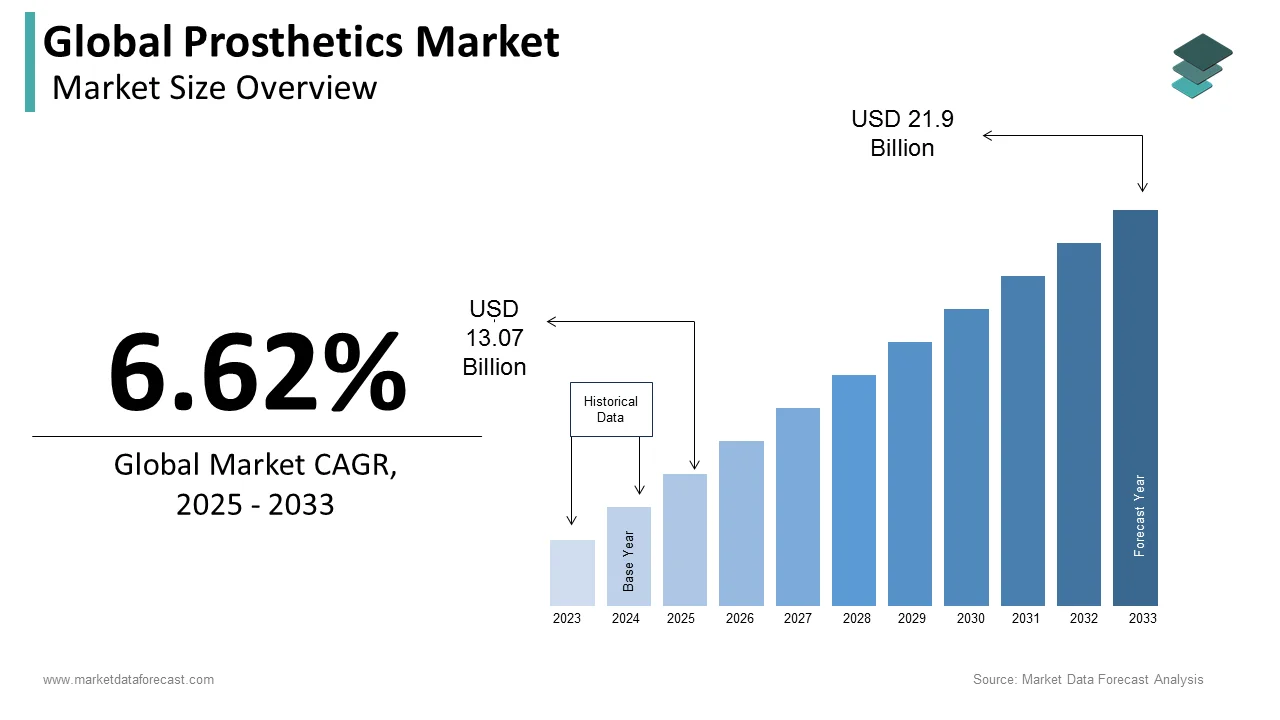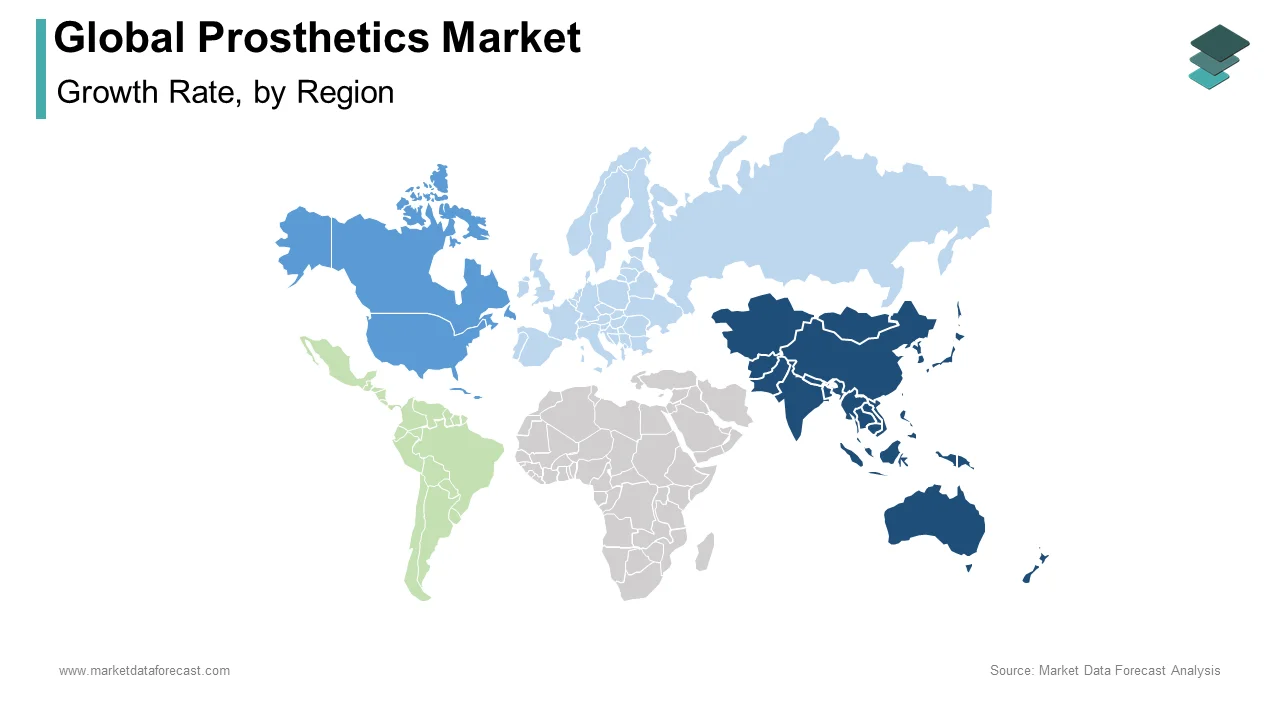Global Prosthetics Market Size, Share, Trends & Growth Forecast Report By Product Type, Technology, End-User and Region (North America, Europe, Asia-Pacific, Latin America, Middle East and Africa), Industry Analysis From 2025 To 2033.
Global Prosthetics Market Size
The size of the global prosthetics market was worth USD 12.3 billion in 2024. The global market is anticipated to grow at a CAGR of 6.62% from 2025 to 2033 and be worth USD 21.9 billion by 2033 from USD 13.07 billion in 2025.

A prosthesis is a medical term for a device that artificially replaces a missing body component. Prostheses are typically devices that replace a missing limb or arm. Although bone, artery, and heart valve replacements are typical, prostheses include artificial eyes and teeth. Eyeglasses and hearing aids, for example, are examples of prosthetics that increase the function of a body part. Prosthetics is the medical discipline of making artificial body parts. The location of the prosthesis, whether above or below the knee, is a crucial bifurcation. Plastic is used to make a form of below-knee prosthesis.
MARKET DRIVERS
The global market for prosthetics is expected to be driven by an increase in sports injuries and road accidents and the prevalence of osteosarcoma around the world.
The rising number of diabetic patients among youngsters and the elderly is a significant growth factor for the global prosthetics market. Because of the rise in amputation surgeries around the world and lower operational costs, the prosthetics market will develop rapidly. Many regulatory authorities and non-governmental organizations responded to the shifting situation during the epidemic. Researchers are experimenting with novel materials such as a graphite-polyurethane composite with graphene on top. These materials function as electric supercapacitors, storing energy and meeting end-user energy conservation needs. Similarly, the graphene component functions as a solar panel, converting sunlight into power to charge the supercapacitor. As a result, companies in the prosthetics market should implement such advancements to make their products more environmentally friendly. Robotic prosthetics, also known as microprocessor-controlled prosthetics, are a new market trend that can be used across the market due to robotics research combined with the latest medical technology.
Prosthetics are becoming more popular as a result of technological improvements.
Researchers at the University of Utah are working on a prosthetic limb with a sense of touch as part of a technological leap. Growing technological advancements allow the global prosthetics market to expand. The growing demand for custom-made orthopedic prosthetics and the widespread availability of technically advanced prosthetics continue to grow profitable opportunities for the prosthetics market in the future years. The use of additive manufacturing/3D printing for prostheses has been gaining traction in the market, particularly among amputees who cannot afford the high cost of traditional limb prosthetics. Prosthetics for the upper limb have become increasingly common in hospitals, with adoption rates gradually increasing. Several significant competitors in the competitive prosthetics market are prioritizing new product introductions to capitalize on opportunities in lower price ranges.
MARKET RESTRAINTS
The rising expense of prosthetics can operate as a market restraint, particularly in underdeveloped countries. However, the high cost of prosthetics and advancements in vascular surgery would limit the prosthetics market's growth in the next few years. Furthermore, the development of the global prosthetics market is further estimated to be hampered by the lack of awareness and the lack of reimbursement schemes.
REPORT COVERAGE
|
REPORT METRIC |
DETAILS |
|
Market Size Available |
2024 to 2033 |
|
Base Year |
2024 |
|
Forecast Period |
2025 to 2033 |
|
CAGR |
6.62% |
|
Segments Covered |
By Product Type, Technology, End-User, and Region. |
|
Various Analyses Covered |
Global, Regional, and country-level analysis; Segment-Level Analysis, DROC; PESTLE Analysis; Porter’s Five Forces Analysis, Competitive Landscape; Analyst Overview of Investment Opportunities |
|
Regions Covered |
North America, Europe, APAC, Latin America, Middle East & Africa |
|
Market Leaders Profiled |
CBPE Capital LLP (Blatchford Limited), Coapt LLC., Colfax Corporation (DJO, LLC), Ossur (college park industries), Mobius Bionics LLC., Motorica LLC., Naked Prosthetics, Ottobock SE & Co. KGaA, Protunix, and Steeper Group., and Others. |
SEGMENTAL ANALYSIS
By Product Type Insights

Because of the rising frequency of joint problems in both developed and developing nations, the prosthetic hand segment accounts for the most prosthetics market share. Other factors driving market expansion include an increase in demand for prosthetic arm devices, an increase in the frequency of accidents, and an increase in the geriatric population.
By Technology Insights
A body-powered prosthesis uses a system of cables or harnesses to control the limb. Other areas of your body, such as your shoulders, elbows, and chest, are used to manipulate the prosthetic arm. Many patients find it a practical choice because it is cheaper, serves as a wonderful supplementary device, and is appropriate for more rugged conditions.
By End-User Insights
In 2024, the prosthetic clinics segment accounted for the majority share of the global prosthetics market. The availability of modern prosthetic technologies and the presence of trained personnel in these healthcare institutions promote their preference, which accounts for the majority of the market share.
REGIONAL ANALYSIS

Over the forecast period, the Asia Pacific market is the fastest-growing regional market in the global prosthetics market. A surge in the incidence of road accidents, rising cases of diabetes-related amputations, and supportive government activities are driving the regional market.
Because of rising government and private investments in healthcare infrastructure and an increase in medical tourism, North America will dominate the prosthetics market in the future. Furthermore, the growing awareness of technology in healthcare would propel the prosthetics market to greater levels throughout the research period. Moreover, the market is predicted to rise due to the rising prevalence of osteosarcoma and sports injuries. In addition, the emphasis on quality of care and value-based services in the U.S. healthcare system has created a favorable market for prosthetics.
Because of its growing population, Germany dominates the European prosthetics market. Furthermore, during the projected period, the increase in awareness will aid the expansion of the prosthetics market in the region.
KEY MARKET PLAYERS
Companies playing a promising role in the global prosthetics market profiled in this report are CBPE Capital LLP (Blatchford Limited), Coapt LLC., Colfax Corporation (DJO, LLC), Ossur (college park industries), Mobius Bionics LLC., Motorica LLC., Naked Prosthetics, Ottobock SE & Co. KGaA, Protunix, and Steeper Group.
RECENT MARKET HAPPENINGS
- The Johnson & Johnson Medical Devices Companies announced in 2020 that DePuy Synthes had introduced its Radial Head Replacement System in the United States, expanding its extremities offering.
- Ossur, a global leader in prosthetic and non-invasive orthopedic technology, has announced the formation of Ossur Japan G.K., a new company situated in Tokyo and is fully operational on January 1, 2021.
MARKET SEGMENTATION
This research report on the global prosthetics market has been segmented and sub-segmented based on the product type, technology, end-user, and region.
By Product Type
- Upper Extremity Prosthetics
- Hand Prosthetics
- Elbow Prosthetics
- Shoulder Prosthetics
- Lower Extremity Prosthetics
- Foot & Ankle Prosthetics
- Knee Prosthetics
- Hip Prosthetics
- Liners
- Sockets
By Technology
- Body Powered
- Electrically Powered
- Hybrid Prosthetics
By End-User
- Prosthetic Clinics
- Hospitals
- Rehabilitation Centers
By Region
- North America
- Europe
- Asia Pacific
- Latin America
- Middle East and Africa
Frequently Asked Questions
What is the presence size of the worldwide prosthetics market?
The global prosthetics market size is expected to be worth USD 13.07 billion in 2024.
What factors are driving the growth of the prosthetics market?
The growth of the prosthetics market is driven by several factors, including the increasing prevalence of chronic diseases and injuries, the growing aging population, and advances in prosthetic technology and materials.
Who are the major players in the prosthetics market?
Some of the major players in the prosthetics market include Össur, Hanger Inc., Fillauer LLC, Blatchford Group, and Ottobock.
What are some of the challenges facing the prosthetics market?
Some of the challenges facing the prosthetics market include the high cost of prosthetic devices, limited insurance coverage for prosthetic devices, and the need for ongoing maintenance and replacement of prosthetic devices over time.
Related Reports
Access the study in MULTIPLE FORMATS
Purchase options starting from $ 2500
Didn’t find what you’re looking for?
TALK TO OUR ANALYST TEAM
Need something within your budget?
NO WORRIES! WE GOT YOU COVERED!
Call us on: +1 888 702 9696 (U.S Toll Free)
Write to us: [email protected]
